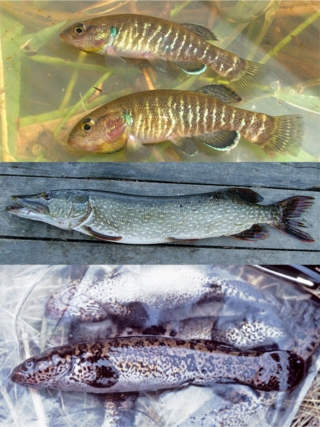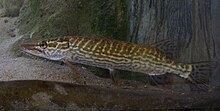The American pickerels are two subspecies of Esox americanus, a medium-sized species of North American freshwater predatory fish belonging to the pike family :

The muskellunge, often shortened to muskie,musky, ski, or lunge, is a species of large freshwater predatory fish native to North America. It is the largest member of the pike family, Esocidae.

Esocidae is a family of fish in the order Esociformes, which contains pike, pickerel, and mudminnows. While the family traditionally only contained the genus Esox, recent genetic and paleontological research have recovered Novumbra and Dallia as members of the family Esocidae, being closer related to Esox than Umbra. Fossil specimens from the Mesozoic in North America have been assigned as two additional genera in this family.

The northern pike is a species of carnivorous fish of the genus Esox (pikes). They are commonly found in moderately salty and fresh waters of the Northern Hemisphere. They are known simply as a pike in Great Britain, Ireland, most of Eastern Europe, Canada and the U.S., although in the Midwest, they may be called a Northern.

Minnow is the common name for a number of species of small freshwater fish, belonging to several genera of the family Cyprinidae and in particular the subfamily Leuciscinae. They are also known in Ireland as pinkeens.

The eastern freshwater cod, also known as the eastern cod or Clarence River cod, is a large predatory freshwater fish of the genus Maccullochella and the family Percichthyidae, that occur in the coastal Clarence River system of north-eastern New South Wales. Eastern freshwater cod are closely related to the Murray cod of the Murray-Darling River system, and are considered an icon of the Clarence River system.

Esox is a genus of freshwater fish commonly known as pike or pickerel. It is the type genus of the family Esocidae. The type species of the genus is Esox lucius, the northern pike.

The tiger muskellunge, commonly called tiger muskie, is a carnivorous fish, and is the usually sterile, hybrid offspring of the true muskellunge and the northern pike. It lives in fresh water and its range extends to Canada, the Northeast, and the Midwest United States. It grows quickly; in one study, tiger muskie grew 1.5 times as fast as muskellunge. Like other hybrid species, tiger muskie are said to have "hybrid vigor," meaning they grow faster and stronger than the parent fish, and are also less susceptible to disease. Trophy specimens weigh about 14 kg (30 lb). Its main diet is fish and small birds. The tiger muskie and the muskie are called the fish of 10,000 casts due to the challenge involved in catching them.

The chain pickerel is a species of freshwater fish in the pike family of order Esociformes. The chain pickerel and the American pickerel belong to the Esox genus of pike.

The zander, sander or pikeperch, is a species of ray-finned fish from the family Percidae, which also includes perch, ruffe and darter. It is found in freshwater and brackish habitats in western Eurasia. It is a popular game fish and has been introduced to a variety of localities outside its native range. It is the type species of the genus Sander.

The powan is a kind of freshwater whitefish endemic to two lochs in Scotland, Loch Lomond and Loch Eck. It has been successfully introduced in two other sites, Loch Sloy and the Carron Valley Reservoir.

Salmo trutta fario, sometimes called the river trout, is a river-dwelling freshwater predatory fish from the genus Salmo of the family Salmonidae. It is one of the three main subspecies of the brown trout, besides sea trout and the lacustrine trout.

The Amur pike, also known as the blackspotted pike, is a pike native to the Amur River system in east Asia, as well as freshwater habitat on the island of Sakhalin. Closely related to the northern pike, it reaches a length of 115 cm, a weight of 12.5 kg (28 lb), sporting a silvery body with small, black spots. Like other pike, this species is prized for sport fishing.

Barbels are group of carp-like freshwater fish, almost all of the genus Barbus. They are usually found in gravel and rocky-bottomed moderate-flowing rivers with high dissolved oxygen content, known as the Barbel zone. A typical adult barbel can range from 25 to 240 cm in length and weigh between 200 g (7.1 oz) and 200 kg (440 lb), depending on species.
The Upper Colorado River Endangered Fish Recovery Program is a multi-agency partnership to recover endangered fish in the upper Colorado River basin while water development proceeds in compliance with state and federal law.
The Colorado pikeminnow is the largest cyprinid fish of North America and one of the largest in the world, with reports of individuals up to 6 ft (1.8 m) long and weighing over 100 pounds (45 kg). Native to the Colorado River Basin of the southwestern United States and adjacent Mexico, it was formerly an important food fish for both Native Americans and European settlers. Once abundant and widespread in the basin, its numbers have declined to the point where it has been extirpated from the Mexican part of its range and was listed as endangered in the US part in 1967, a fate shared by the three other large Colorado Basin endemic fish species: bonytail chub, humpback chub, and razorback sucker. The Colorado pikeminnow is currently listed as vulnerable by the IUCN, while its NatureServe conservation status is "critically imperiled".

The brook stickleback is a small freshwater fish that is distributed across the US and Canada. It grows to a length of about 2 inches. It occupies the northern part of the eastern United States, as well as the southern half of Canada. Small populations are scattered throughout the Mississippi-Great Lakes basin extending to Colorado, New Mexico, Kentucky, Tennessee, etc., though some of these areas are not native to the species. This small fish inhabits clear, cool streams and lakes. They eat small invertebrates, algae, insect larvae, and occasionally their own eggs. They are also preyed upon by smallmouth bass and northern pike. Feeding time is usually dawn and sunset. The brook stickleback does have active competition mostly from minnows, but feeding times are different, along with diet. Spawning occurs in midsummer. Males secure a territory, build a nest, and mate with females. Males provide protection for the eggs, ward off predators, and usually die later in the season. This is considered an annual species. The nests are built out of aquatic grasses. Though the brook stickleback is not considered a threatened species, deforesting and changing waters are altering ecosystems of the species. Harvesting of trees around riparian environments is having a large effect of the stream ecosystem where the brook stickleback resides.
The Aquitanian pike is a species of pike, a predatory fish native from the Charente to the Adour river drainages in the French Great South-West region. It was scientifically described in 2014, but had formerly been regarded as a population of the widespread northern pike. The two species generally resemble each other and they are able to hybridize. This represents as threat to the relatively localized Aquitanian pike, as northern pikes commonly have been used to stock places previously only inhabited by the Aquitanian pike; historically, the two had fully separated distributions.

The redfin pickerel is a subspecies of freshwater fish belonging to the pike family (Esocidae) of the order Esociformes. Not to be confused with its close relatives, the grass pickerel and the chain pickerel, this fish is unique in the fact that it has brightly colored red fins. Like all pikes, the redfin pickerel is an ambush predator, lying amongst thick vegetation in wait for smaller, more agile prey to enter within its range of attack.















